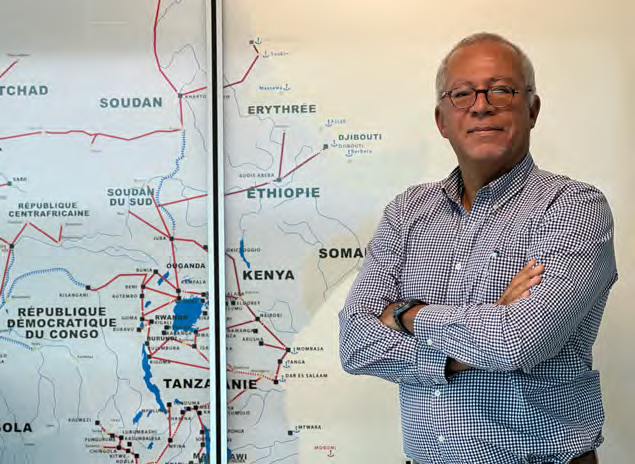Rodolphe Kembukuswa, General Manager of Operations of African Global Logistics, Southern Region, spoke with M&B Magazine. He talked about the absorption of the transport and logistics activities in Africa of the Bolloré Group by the Swiss MSC, and the prospects of this industry sector on the economy of the region.
Hello Rodolphe Kembukuswa, can you introduce yourself?
I am 59 years old, 33 of which have been with the Bolloré Group, which I joined as soon as I finished my university studies. I have been managing Katanga for five years. Previously, I was posted in Antwerp, Kinshasa, Kigali, Dar es Salaam and Eastern Congo.
In March 2022, the Bolloré Transport & Logistics group signed an agreement with the Swiss group MSC to sell its transport and logistics activities in Africa. From your point of view, what will be the benefits of this change of ownership for your portfolio in DRC?
As far as the DRC is concerned, there will be a necessary adaptation at first in relation to our current activities because MSC, the world’s leading shipowner, is not established in the DRC or was not, in any case, at the time of the sale which took place in December 2022. As far as our entity is concerned, joining forces with a major shipowner should give us a boost in terms of investment in the region, at least I hope so, as well as providing us with clear added value in our usual sectors of activity, whether for clearing forwarding, but also for the development that we expect in the framework of the supply chain in the DRC. I’m thinking mainly of an upgrade of the warehouses, which will allow us to optimize the stock management and to bring added value to our mining customers, and also infrastructure and handling means. I think it will be an obvious addition to our activities and it will allow us to reach certain areas of logistics that we did not necessarily reach before.
The Benguela railroad will soon be opened to the private sector, and the operation and maintenance of the railway infrastructure and the transport of goods by rail will be conceded to the Lobito Corridor Management Consortium. Firstly, what do you think about this and secondly, how can this “new road” change the situation of your activities in the southern region of the DRC?
To answer part of your question, this is a project that has now been completed. There is a consortium that has received this concession from the Angolan authorities to develop the Lobito corridor for 30 years, with a possible 20-year extension.
This consortium is made up of Trafigura, Mota-Engil and Vecturis, which will be the rail operator. I think we will see the first significant developments during the year 2023. For us, this is very important because it provides an alternative to the huge logistics and transport problems we have in the region, which is no secret.
The volume of road transport at present and the infrastructure in place, especially the border posts of Kasumbalesa, do not allow for an efficient and fluid service in the movement of goods. This additional corridor will help reduce the pressure on border crossings like Kasumbalesa. We are in a period of ecological change and transition, so I would say that rail transport is the solution for the transport of goods such as ores or raw materials for the mining industry. It is still quite disturbing to see that most of these movements are still done by road while there is an under-exploited rail network in the sub-region. From an ecological point of view, this is obviously a solution that can only be positive.
According to the information in my possession, the Lobito corridor is expected to become the third corridor in Southern Africa by 2050. It is a corridor that has existed for a very long time for flows from Katanga and the Copperbelt, but which was interrupted during the Angolan civil war. This corridor should be made fully operational in the coming years.
The only thing that concerns us, as Congolese operators, is that in fact the railway concession between Lobito, on the Angolan Atlantic coast, and the DRC stops at Luao, which is the border with the DRC, and the border post of Dilolo. There are still about 425 kilometers of track in poor condition on the Congolese section.
It will be essential for the railway operator of this concession of the Benguela railway to obtain from the SNCC the necessary agreements to contribute to the repair of the infrastructure on the Congolese side and to organize the transfers of rolling stock between the two entities. If we solve this problem of the Congolese section, I think it will be a corridor that will help to relieve the current border posts, but also allow us to organize the movement of volumes that are constantly growing on the DRC side, and possibly establish a connection with the Zambian network via Lubumbashi and Sakania.
It is therefore a dossier that we are following closely, and I think that we are now in the concrete reality, knowing that the coming months will be decisive.
The major mining operators in Katanga have already spoken very favorably of this project and for them too, it is a question of opening up another corridor to be less dependent on the usual flows, either from Dar es Salaam or from Durban. So you can see that this is very important.
In relation to the acquisition by the shipowner MSC of our African networks, the developments that this rail corridor will bring for the Katanga /Copperbelt region are very important, because it will be a containerized traffic. It is therefore a phenomenal opportunity for us to be able to partner with the world’s leading shipping company in the development of the Southern and Eastern African corridors to help solve the logistical and infrastructure challenges that will inevitably result from the forecasted considerable increase in volumes in the Region over the next 10 years and beyond…
Zambia and the DRC plan construction on the strategic Kasomeno-Kasenga-Mwenda road in August 2023. How much would a high-level road infrastructure linking the DRC to its neighbors boost the Congolese economy?
I will say once again that it is positive since it is a new exit route that could open up for Katanga flows, even if we join the Dar es Salaam Corridor in the end while reducing the mileage by more than 300km …. I believe that the biggest problem facing the Congolese economy, especially in the southern part, is the problem of evacuating its mineral production through a single border post, which is that of Kasumbalesa. I was talking earlier about the recurrent congestion that can be seen there. We had 80 kilometers of tail on the Zambian side a few weeks ago, and even if this has been more or less reduced, we are still around 40 to 50 kilometers at the moment, so it is a real funnel in both directions.
The goal of the DRC is to multiply or at least to have alternative exits, which allow the decongestion of the current roads which are totally saturated. We can think of the Sakania border post with its dry port facilities and the renovation of the road axis of about 150 kilometers between Sakania and the Kasumbalesa road. But once again, the initiatives taken in terms of infrastructure must be done jointly with neighboring countries so that a real improvement in the flow of volumes can be observed.
The Kasomeno road that you mentioned will be another possible exit point, like others that are much talked about, such as Solwezi between Lualaba and Zambia, and the rehabilitation of the Kipushi exit post.
Here we are talking about road transport and trying to find alternative routes to the bottleneck in Kasumbalesa. It is essential that initiatives such as these be carried out. The Kasomeno road in question will reduce about 300 kilometers of routing between Kolwezi, Lubumbashi and Dar es Salaam compared to the current route and especially will contribute to decongest Kasumbalesa de facto.
For the future, I am obviously convinced that these road axes that are now in place or rehabilitated, will clearly contribute to develop and allow the evacuation of volumes that we expect in future years for the DRC. As said before, it is imperative that the initiatives are well coordinated on both sides of the border but the interests and the notion of priority or urgency may not be perceived in the same way by the governments and administrative entities of the respective countries.
We were talking about Sakania where the infrastructure is indeed impressive on the Congolese side. On the other hand, absolutely not on the Zambian side. So it is good to have truck reception, storage, etc. capacities on one side of the border.
But if the infrastructure on the other side is not upgraded, then I fear that we will again face a bottleneck on the Zambian side. The Sakania-Ndola road, which is only about 20 kilometers long, is in a catastrophic state, and above all, there are no reception parking lots on the Zambian side that can accommodate Congolese traffic.
Let’s get back to African Global Logistics, what does the future hold for your new shareholder in the DRC and in the region?
As far as the DRC in general is concerned, it will now have to integrate Kinshasa and the western facade of Matadi, Boma and Muanda with its shipping activities. Here, there will obviously be a notable change since MSC, our new shareholder, has inserted Pointe Noire in its West Africa service for mother ships and launched a feeder service serving the DRC from Pointe Noire in February. This is a weekly feedering service that will change the game for MSC’s development in the DRC as it will create MSC traffic on the Matadi – Kinshasa perimeter, with the creation of MSC shipping agencies on the spot that can rely on our long-standing presence throughout the country for clearing forwarding and logistic activities.
For our Western agencies, it is a new dynamic which is announced with the arrival of MSC flows in their perimeter which should boost their activities.
As far as we are concerned, for the Southern part (as well as the Eastern part), the same organization will remain in place since MSC will not be present on its own.
As I said at the beginning of the interview, this acquisition offers us some good prospects in terms of investments to accompany our development in the South region, bearing in mind the growing volumes that should reach 3 million tons for copper and cobalt next year and probably more than 4 million tons by 2030.
This shows a very significant potential for development and growth and that is why a shipowner like MSC must be present in a territory like this. Regarding the problem of the transport of minerals, the importance of the development of containerized traffic by rail expected, also represents a major interest for a shipowner like MSC and justifies its presence in this area, despite its landlocked situation.
In the near future, the acquisition by MSC will probably allow us to develop our shipping activities more closely locally. I really believe that the volumes we are talking about for this sub-region are huge growth levers for all the activities related to logistics and if the challenges are huge, contributing to take them up in the years to come is all the more interesting!
Exergue
Volumes are expected to grow to 3 million tons for copper and cobalt in 2024 and probably more than 4 million tons by 2030
Rail transport is the obvious solution for the transportation of goods such as ores or raw materials for the mining industry.
Interview by Marie-Aude Delafoy for M&B – Lubumbashi, March 13, 2023.
Photos @Photo.AfricaInside


